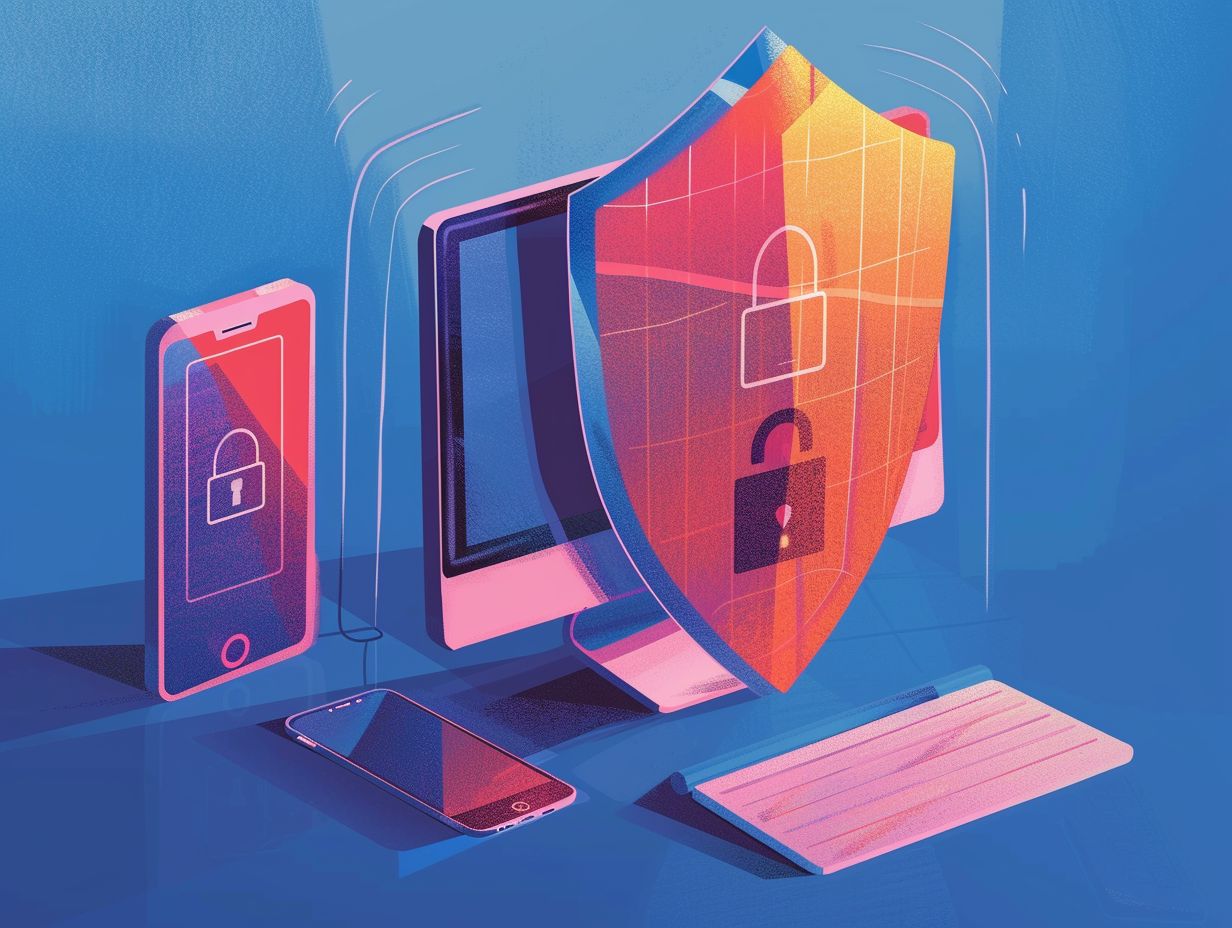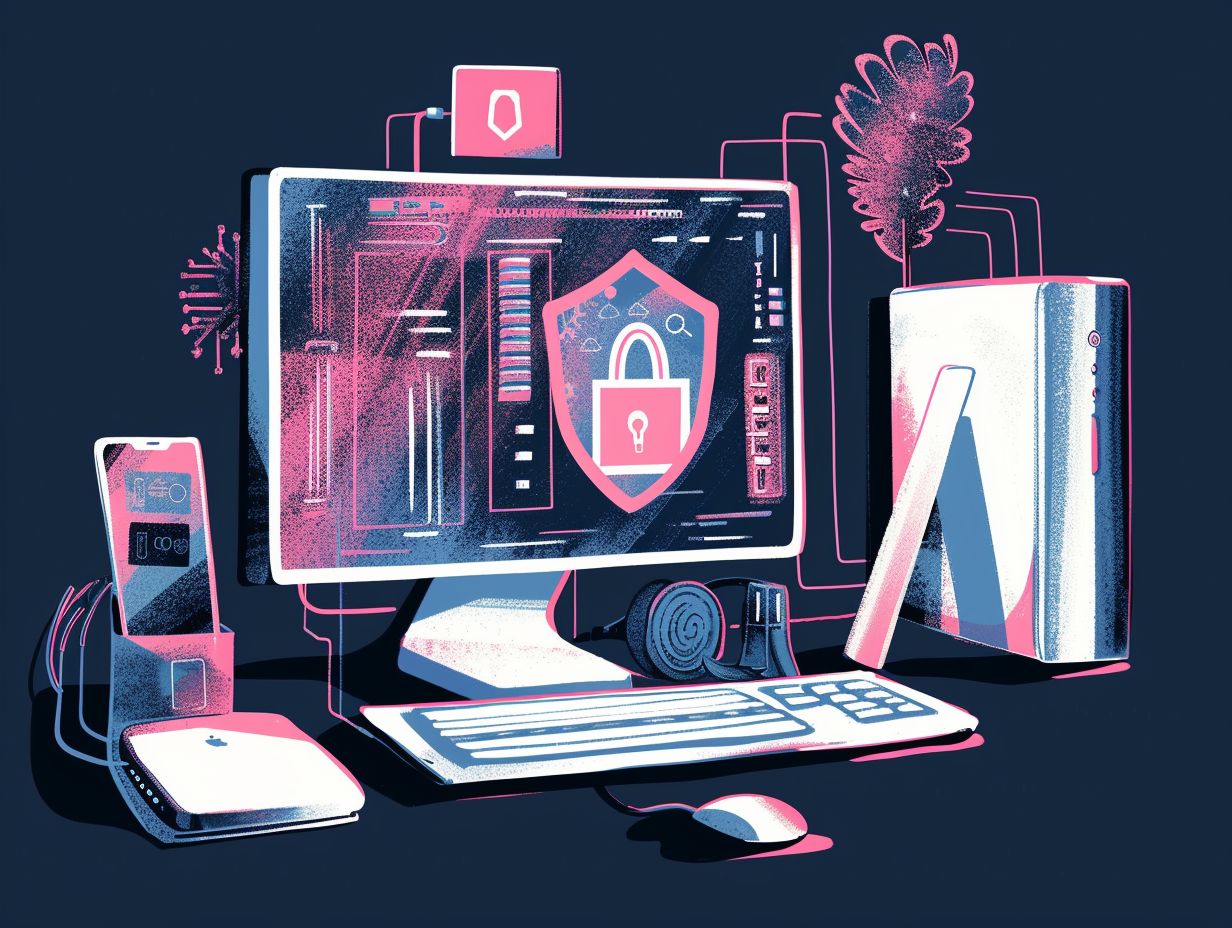Mitigating Cyber Risks In Mobile And Online Banking Services

In today’s digitized world, the importance of cybersecurity in banking cannot be overstated. Cyber attacks pose significant risks and consequences, especially in mobile and online banking. Phishing, social engineering, malware, and ransomware are just a few of the types of cyber risks that consumers face.
Measures can be taken to mitigate these risks, such as encryption, multi-factor authentication, and regular security updates. By following best practices like protecting personal information and monitoring account activity, individuals can ensure safe mobile and online banking experiences.
Key Takeaways:

The Importance of Cybersecurity in Banking
In the realm of banking, you must acknowledge the paramount importance of cybersecurity, particularly in light of the escalating cyber threats and risks that confront financial institutions, customers, and the wider fintech sector. The capacity to safeguard sensitive data, counter security risks, and adhere to regulatory standards is essential for upholding trust and defending against potential financial liabilities.
With technological advancement comes a corresponding evolution in the techniques employed by cybercriminals to exploit vulnerabilities within the financial industry. Banks are consistently enhancing their security protocols to proactively address emerging threats, spanning from phishing schemes and ransomware assaults to insider breaches and social engineering ploys.
The adoption of robust risk mitigation strategies and the allocation of resources towards state-of-the-art cybersecurity solutions are imperative for preserving the confidentiality of sensitive financial data. Adherence to stringent industry regulations such as PCI DSS and GDPR is non-negotiable, serving as a critical safeguard against regulatory sanctions and reputational harm.
Risks and Consequences of Cyber Attacks
Cyber attacks pose significant risks and consequences for financial institutions, ranging from devastating data breaches that lead to financial losses to the need for comprehensive cyber liability coverage and adherence to strict regulatory guidance and laws. These risks are further heightened by the potential impact on customer trust and loyalty, as well as the threat of reputational damage.
In the banking industry, a cyber attack can not only result in stolen funds and disrupted services but also in the exposure of sensitive customer data, leaving individuals vulnerable to identity theft and fraud. The financial impacts of such breaches can be immense, with the cost of recovery, litigation, and compensation adding up quickly.
Cyber insurance policies play a crucial role in mitigating these risks, providing financial protection and support in the event of a cyber incident. Regulatory compliance is essential to minimize vulnerabilities and ensure that banks are following best practices to safeguard their systems and data.
Types of Cyber Risks in Mobile and Online Banking
In terms of mobile and online banking, you are exposed to various types of cyber risks, such as malware attacks, authentication vulnerabilities, and compliance challenges related to data protection and regulatory frameworks like NIST standards for network security.
These risks can pose significant threats to the security of your personal and financial information stored and transmitted through digital banking channels. Malware threats, such as trojans and spyware, have the potential to compromise sensitive data and lead to financial fraud. Weak authentication protocols create opportunities for cybercriminals to gain unauthorized access to your accounts.
It is essential to meet compliance requirements, such as the implementation of strong encryption and secure login procedures, to safeguard customer data effectively. By adopting best practices like multi-factor authentication and ensuring regular security updates, you can mitigate these risks and enhance the overall security of your network.
Phishing and Social Engineering

Phishing and social engineering tactics rank among the most prevalent cyber threats that target mobile and online banking platforms, underscoring the importance of robust risk assessment processes and adherence to OWASP guidelines for secure web applications.
These malicious tactics frequently employ deceptive measures, such as email spoofing, counterfeit websites, or phone scams, with the aim of deceiving unsuspecting individuals into revealing confidential information like login credentials, personal details, or financial data.
By capitalizing on human psychology and trust, cybercriminals can illicitly access accounts, leading to identity theft, financial fraud, and other grave repercussions for both customers and financial institutions.
Carrying out routine risk assessments and adopting OWASP best practices, including input validation, session management, and encryption, plays a critical role in fortifying defenses against these constantly evolving threats.
Malware and Ransomware
The proliferation of malware and ransomware presents significant cyber threats to your mobile and online banking systems, emphasizing the critical role of implementing robust controls and conducting thorough risk assessments to protect against malicious attacks.
These cyber threats can result in severe financial losses, reputational damage, and customer distrust if not adequately addressed. To prevent such attacks, you must prioritize measures such as multi-factor authentication, encryption protocols, intrusion detection systems, and regular security updates.
Continuous risk assessment is vital for you to identify emerging vulnerabilities and adapt security controls accordingly, ensuring a proactive approach to cybersecurity. By staying vigilant and investing in comprehensive cybersecurity strategies, you can better safeguard your systems and customer data from the ever-evolving landscape of cyber threats.
Measures to Mitigate Cyber Risks
In terms of mitigating cyber risks in mobile and online banking, you need to take a multi-faceted approach. This involves implementing robust authentication protocols, utilizing advanced technology solutions, forming strategic partnerships with cybersecurity vendors, and ensuring compliance with strict regulations.
To enhance the security of customer accounts and transactions, it is crucial to incorporate strong authentication methods like biometrics, two-factor authentication, and token-based systems.
Adhering to cybersecurity best practices such as conducting regular security audits, encrypting sensitive data, and providing employee training on identifying phishing attempts is essential for preventing data breaches.
Collaborating with reputable cybersecurity vendors to implement cutting-edge technologies like AI-based threat detection and firewall protection can significantly bolster a bank’s defense against cyber threats.
By following regulatory frameworks such as GDPR and PCI DSS, you can ensure that data protection standards are consistently met.
Encryption and Multi-Factor Authentication
Incorporating encryption and multi-factor authentication is essential for enhancing the security of mobile and online banking platforms. These measures help safeguard sensitive data and mitigate cyber threats by implementing effective data classification and authentication processes.
When encryption is utilized, organizations can transform data into an unreadable format, rendering it incomprehensible to unauthorized individuals who may attempt to intercept sensitive information. This security layer ensures that even in the event of a data breach, the information remains unintelligible, preserving its confidentiality and integrity.
Furthermore, multi-factor authentication introduces an additional layer of security by necessitating multiple forms of verification before granting access. This approach significantly reduces the likelihood of unauthorized access to the system.
Along with encryption and multi-factor authentication, data classification is crucial for strengthening security measures. By categorizing information based on its level of sensitivity, organizations can apply suitable security controls and allocate resources more efficiently to protect valuable assets.
Regular Security Updates and Patches

Regular security updates and patches are essential components of maintaining a secure environment for mobile and online banking operations, reducing the risk of cyber threats, and minimizing the potential for network business interruption due to vulnerabilities.
By consistently updating your security protocols, you can stay ahead in the ongoing battle against cybercriminals. Technology plays a vital role in this process, providing tools for conducting thorough risk assessments. Identifying vulnerabilities early on enables proactive measures to be taken, preventing potential network disruptions that could compromise sensitive data.
The constant evolution of threats necessitates a dynamic approach to cybersecurity, where regular updates serve as a frontline defense. Adhering to best practices and promptly addressing security gaps can safeguard both financial institutions and their customers from digital breaches.
Best Practices for Safe Mobile and Online Banking
Implementing best practices for safe mobile and online banking involves securing your mobile devices, enhancing data protection measures, strengthening authentication mechanisms, and addressing privacy liability concerns to ensure the security and privacy of customer information.
Starting with mobile device security, it is crucial for you to use reliable antivirus software and keep your devices updated with the latest security patches. Encrypting sensitive data and enabling remote wipe capabilities can add an extra layer of protection. Your data protection strategies should include regular backups of important information and storing data in encrypted formats.
In terms of authentication protocols, you should utilize multi-factor authentication methods and avoid easily guessable passwords. Privacy liability considerations involve compliance with data protection regulations and promptly addressing any security breaches to safeguard customer data.
Protecting Personal Information
Protecting your personal information is essential in mobile and online banking to shield you from data breaches and privacy liability risks. This requires implementing robust data protection measures and adhering to strict privacy regulations.
Safeguarding your personal data is pivotal for upholding the trust and confidence of customers within the banking sector. As digital banking services become increasingly prevalent, the protection of sensitive information has never been more critical. By deploying encryption methods, multi-factor authentication, and conducting regular security audits, financial institutions can mitigate the risks associated with unauthorized access and data breaches.
Educating you on safe online practices and providing secure platforms are crucial steps in preventing privacy infringements and ensuring a secure banking experience.
Monitoring Account Activity
Monitoring account activity is a critical practice for financial institutions engaged in mobile and online banking to detect and prevent fraudulent transactions, ensure compliance with regulatory requirements, and protect customers from financial fraud.
By continuously monitoring account activity, you can swiftly identify any unusual or suspicious transactions that deviate from your typical spending patterns, alerting you to potential fraud in real-time. This proactive approach not only helps in safeguarding your funds but also ensures that the financial institution adheres to stringent regulations set forth by governing bodies.
Regular monitoring also allows for quick intervention in case of any detected fraudulent activity, thus minimizing potential financial losses and maintaining trust and confidence amongst customers who rely on secure banking services.
Frequently Asked Questions

What are cyber risks in mobile and online banking services?
Cyber risks in mobile and online banking services refer to potential threats and vulnerabilities that can compromise the security and privacy of financial transactions and sensitive customer information.
How do cyber risks affect mobile and online banking services?
Cyber risks can lead to unauthorized access to accounts, identity theft, financial fraud, and other forms of cybercrime, causing financial losses and damage to a bank’s reputation.
What measures can be taken to mitigate cyber risks in mobile and online banking services?
To mitigate cyber risks, banks should implement robust security measures such as multi-factor authentication, encryption, and regular software updates. They should also conduct regular risk assessments and provide cybersecurity training to employees.
What role does customer awareness play in mitigating cyber risks in mobile and online banking services?
Customer awareness is crucial in mitigating cyber risks. Customers should be educated about potential threats and how to protect their personal information and financial transactions. This can include using strong passwords, avoiding public Wi-Fi for banking, and being cautious of phishing scams.
What is the responsibility of banks in mitigating cyber risks in mobile and online banking services?
Banks have a responsibility to ensure the security of their online and mobile banking services. This includes implementing strong security measures, regularly monitoring and updating systems, and promptly reporting any incidents to customers.
How can customers protect themselves from cyber risks in mobile and online banking services?
Customers can protect themselves by regularly monitoring their accounts, using strong and unique passwords, avoiding sharing personal information online, and being cautious of suspicious emails or messages. They should also regularly update their devices and use security software.









